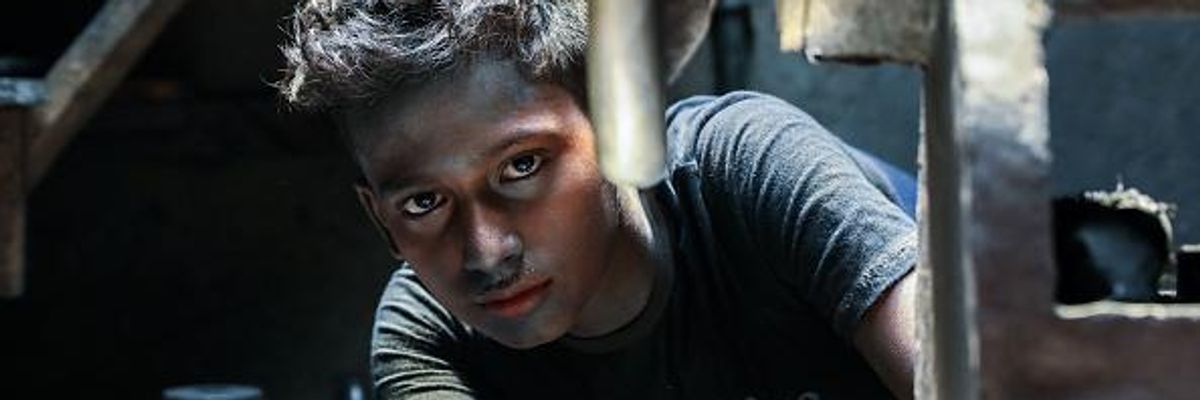As the Covid-19 pandemic and corresponding economic upheaval threaten to push up to 150 million people into extreme poverty by 2021, in-depth reporting Thursday from the Associated Press showed that the coronavirus crisis is also undermining two decades of gains against child labor in the developing world, where an entire generation of impoverished children lacking access to safe education opportunities are being driven by economic necessity to work alongside their parents or in place of unemployed caretakers.
Progressive author and commentator Nathan Robinson said Thursday on social media that the dire situation demonstrates the depravity of the global economic system and its inability to guarantee the well-being of all the world's inhabitants despite there being more than enough resources to do so. "Capitalism is monstrous," he said.
Robinson also noted that it's a "good time to remember that a number of free market economists defend child labor as being a good thing because it's 'freely chosen' and work is good, so prohibiting it would be 'coercive.'"
In a Twitter thread, Robinson cited multiple examples of economists defending the alleged virtues of child labor, which Jeffrey Tucker of the right-wing think tank American Institute for Economic Research for instance described as an "opportunity [taken] away from kids" by compulsory schooling.
Tucker's euphemizing of child labor, which he imagines to be "exciting," is diametrically opposed to the AP's horrifying account of the resurgence of young people--coerced by worsening poverty and disrupted learning routines amid the coronavirus crisis--taking on often dangerous work to help keep their families from going hungry or becoming homeless.
"With classrooms shuttered and parents losing their jobs, children are trading their ABC's for the D of drudgery," wrote Maria Verza, Carlos Valdez, and William Costa in AP. "Reading, writing, and times tables are giving way to sweat, blisters, and fading hopes for a better life."
The journalists provide numerous examples of what potentially millions of children around the globe are doing now instead of going to school: "Children in Kenya are grinding rocks in quarries. Tens of thousands of children in India have poured into farm fields and factories. Across Latin America, kids are making bricks, building furniture, and clearing brush."
In addition to several harrowing photographs, AP shared the following video depicting the haunting "sounds of child labor":
"These children and adolescents," AP noted, "are earning pennies or at best a few dollars a day to help put food on the table"--putting in long hours at jobs that used to be after-school activities but have in recent months been transformed into full-time work.
Astrid Hollander, UNICEF's head of education in Mexico explained that "child labor becomes a survival mechanism for many families."
"We have seen new children and adolescents selling in the street," Patricia Velasco, manager of a city program for at-risk people in La Paz, Bolivia, told AP. "They've been pushed to generate income."
Child workers interviewed by AP told reporters that they missed school but understood the need to assist their families, and their parents expressed dismay at the implications of interrupted schooling.
Despite resource constraints, caretakers explained that they are doing their best to prevent their children from falling behind.
"Under their mother's watchful eye, the children work through schoolbooks they were given in February at the start of the school year," wrote Verza, Valdez, and Costa in AP. "Each morning in the workshop, she has them take time to study."
According to the news agency, governments are still trying to figure out exactly how many students have dropped out of their school systems, but with 1.5 billion schoolchildren affected by school closures at the height of national lockdowns, UNICEF has estimated that the worldwide numbers are likely in the millions.
Moreover, for at least 463 million children whose schools closed due to Covid-19, remote learning is not a possibility, prompting UNICEF executive director Henrietta Fore in August to declare the widespread disruptions in learning a "global education emergency."
Experts explained to AP that "in the past, most students who have missed class because of crises like the Ebola epidemic returned when schools reopened."
"But the longer the crisis drags on," they said, "the less likely [children and adolescents] will be to go back."
According to Fore, "the repercussions could be felt in economies and societies for decades to come," which is why UNICEF's Reimagine campaign calls for "urgent investment to bridge the digital divide, reach every child with remote learning, and, most critically, prioritize the safe reopening of schools."

